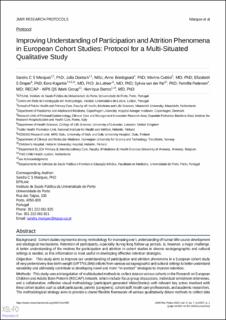| dc.contributor.author | Marques, Sandra C.S. | |
| dc.contributor.author | Doetsch, Julia | |
| dc.contributor.author | Brødsgaard, Anne | |
| dc.contributor.author | Cuttini, Marina | |
| dc.contributor.author | Draper, Elizabeth S. | |
| dc.contributor.author | Kajantie, Eero | |
| dc.contributor.author | Lebeer, Jo | |
| dc.contributor.author | der Pal, Sylvia van | |
| dc.contributor.author | Pedersen, Pernille | |
| dc.contributor.author | Barros, Henrique | |
| dc.contributor.author | Abate, Georgia | |
| dc.contributor.author | Evensen, Kari Anne Indredavik | |
| dc.contributor.author | Indredavik, Marit Sæbø | |
| dc.contributor.author | Sarrechia, Iemke | |
| dc.contributor.author | Virtanen, Eeva | |
| dc.date.accessioned | 2022-09-01T09:29:01Z | |
| dc.date.available | 2022-09-01T09:29:01Z | |
| dc.date.created | 2021-01-30T16:41:46Z | |
| dc.date.issued | 2020 | |
| dc.identifier.citation | JMIR Research Protocols. 2020, 9 (7), . | en_US |
| dc.identifier.issn | 1929-0748 | |
| dc.identifier.uri | https://hdl.handle.net/11250/3015066 | |
| dc.description.abstract | Background: Cohort studies represent a strong methodology for increasing one’s understanding of human life-course development and etiological mechanisms. Retention of participants, especially during long follow-up periods, is, however, a major challenge. A better understanding of the motives for participation and attrition in cohort studies in diverse sociogeographic and cultural settings is needed, as this information is most useful in developing effective retention strategies.
Objective: This study aims to improve our understanding of participation and attrition phenomena in a European cohort study of very preterm/very-low-birth-weight (VPT/VLBW) infants from various sociogeographic and cultural settings to better understand variability and ultimately contribute to developing novel and more “in-context” strategies to improve retention.
Methods: This study uses a triangulation of multisituated methods to collect data on various cohorts in the Research on European Children and Adults Born Preterm (RECAP) network, which include focus group discussions, individual semidriven interviews, and a collaborative, reflexive visual methodology (participant-generated VideoStories) with relevant key actors involved with these cohort studies such as adult participants, parents (caregivers), cohort staff, health care professionals, and academic researchers. The methodological strategy aims to provide a shared flexible framework of various qualitatively driven methods to collect data on VPT/VLBW adult and child cohorts, from which research partners may choose and combine those most pertinent to apply in their own specific contexts. Data from all sources and sites will be submitted to a triangulation of phenomenological thematic analysis with discourse analysis.
Results: As of January 2020, in this study, we enrolled 92 participants variously involved with child and adult RECAP partnering cohorts from six countries. Multisite enrollment and data collection are expected to be completed in all seven study settings by June 2020. Findings will be reported in future publications.
Conclusions: Qualitative research methods are a useful complement for enriching and illuminating quantitative results. We expect that opting for a multisituated study approach addressing the interplay of the lived experience of individuals in both researcher and researched stances of particular cohort study settings will contribute to filling some gaps in the understanding of participation variability and effectiveness of different implemented strategies in context. Moreover, health research subjects have traditionally been positioned as passive objects of study rather than active participants, even though they have the greatest stake in improving health care policies and practices. Including collaborative methods allows us to counteract the “top-down” model by handing over some research control to the very people who are providing the data on which research findings will be based while also acknowledging the value of their involvement. | en_US |
| dc.language.iso | eng | en_US |
| dc.publisher | JMIR Publications | en_US |
| dc.rights | Navngivelse 4.0 Internasjonal | * |
| dc.rights.uri | http://creativecommons.org/licenses/by/4.0/deed.no | * |
| dc.subject | Frafall | en_US |
| dc.subject | Drop-out | en_US |
| dc.subject | Lav fødselsvekt | en_US |
| dc.subject | Low birth weigth | en_US |
| dc.subject | Deltagelse | en_US |
| dc.subject | Participation | en_US |
| dc.subject | Preterm fødsel | en_US |
| dc.subject | Preterm birth | en_US |
| dc.subject | Kvalitativ forskningsmetode | en_US |
| dc.subject | Qualitative research | en_US |
| dc.title | Improving understanding of participation and attrition Phenomena in European cohort studies: Protocol for a multi-situated qualitative study | en_US |
| dc.title.alternative | Improving understanding of participation and attrition Phenomena in European cohort studies: Protocol for a multi-situated qualitative study | en_US |
| dc.type | Peer reviewed | en_US |
| dc.type | Journal article | en_US |
| dc.description.version | publishedVersion | en_US |
| dc.subject.nsi | VDP::Medisinske fag: 700 | en_US |
| dc.subject.nsi | VDP::Midical sciences: 700 | en_US |
| dc.source.pagenumber | 0 | en_US |
| dc.source.volume | 9 | en_US |
| dc.source.journal | JMIR Research Protocols | en_US |
| dc.source.issue | 7 | en_US |
| dc.identifier.doi | 10.2196/14997 | |
| dc.identifier.cristin | 1883341 | |
| dc.relation.project | EU/733280 | en_US |
| cristin.ispublished | true | |
| cristin.fulltext | original | |
| cristin.qualitycode | 1 | |

